E英语教程U
- 格式:pptx
- 大小:3.34 MB
- 文档页数:22
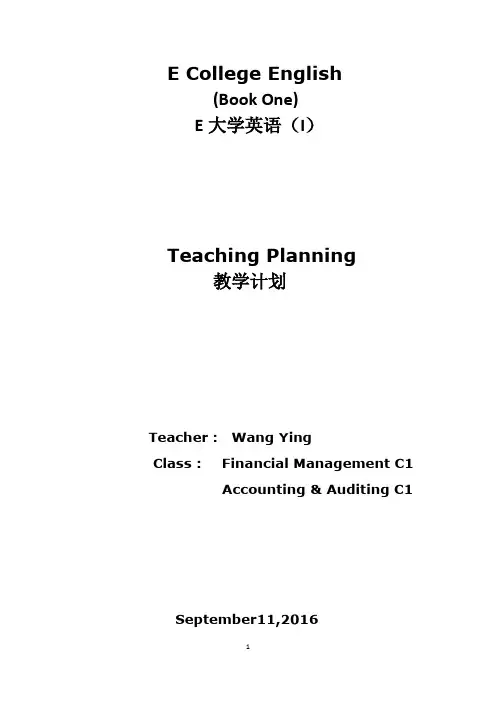
E College English(Book One)E大学英语(I)Teaching Planning教学计划Teacher : Wang YingClass : Financial Management C1Accounting & Auditing C1 September11,2016Unit II Teaching objectives:1.Distinguish confusing pronunciations;2.Learn how to express greeting & response, making introductions & response;3.Improve reading skills;4.Grasp the main idea and the structure of the text;5. Master the key words and phrases and sentence patterns in the text;6.Practice grammar using in writing.7.Conduct a series of reading, listening, speaking related to the theme of the unit;8.Learn culture relatedII Teaching Allotment1.Listening (45mins)A. Skills: listening to the stressed wordsB. Functions: how to express greetings & response.C. Conversation one:D. Conversation two :E. Practice: conversation one and two and exercises.2.Speaking (45mins)A . Conclude the phrases about expressing greeting & responseB. Role - playC. Activities: role-play several situations according to guided conversationD. Discussion after listening:E. Passage listening :F. Discussion:3.Passage A study(4 sections):4.Passage B study(2 sections):5.Exercise & grammar practice(2sections):III Detailed study of text AA Mothe r’s Letter to the WorldLead-in (20 mins)A.Video watching & extended readingB.Warming-upQ1. Do you still remember what your parents told you when you started school ?What is it ?Q2. What are your parents’ expectation of you ? Have you realized them?Q3. What would you say to your parents when it is time for you to leavehome and start your own life?Q4. If it is time for your own child to go out into adult world, what would you say to him / her ?Language points.1. Title writing rules : A Mother’s Letter to the World(首字母大写,中间的虚词不大写)。
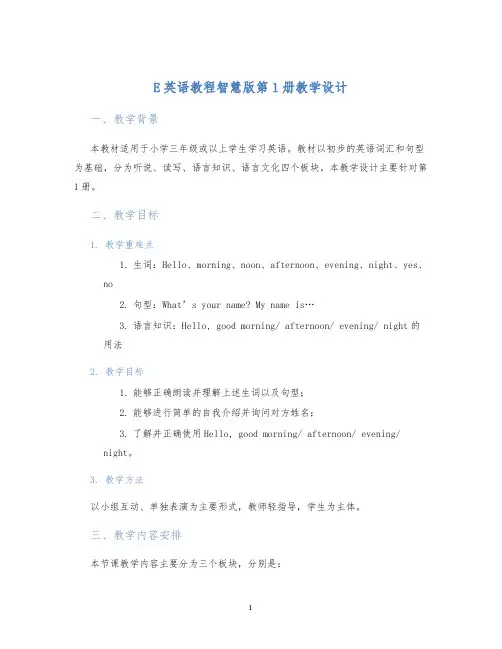
E英语教程智慧版第1册教学设计一、教学背景本教材适用于小学三年级或以上学生学习英语。
教材以初步的英语词汇和句型为基础,分为听说、读写、语言知识、语言文化四个板块。
本教学设计主要针对第1册。
二、教学目标1. 教学重难点1.生词:Hello、morning、noon、afternoon、evening、night、yes、no2.句型:What’s your name? My name is…3.语言知识:Hello, good morning/ afternoon/ evening/ night的用法2. 教学目标1.能够正确朗读并理解上述生词以及句型;2.能够进行简单的自我介绍并询问对方姓名;3.了解并正确使用Hello, good morning/ afternoon/ evening/night。
3. 教学方法以小组互动、单独表演为主要形式,教师轻指导,学生为主体。
三、教学内容安排本节课教学内容主要分为三个板块,分别是:1. 观看视频并学习新词汇根据学生年龄层次选择针对性较强、趣味性强的视频材料,如儿歌等。
利用视频中出现的英语单词和句型,引导学生学习新词汇,并介绍英语问候语的基本用法。
2. 进行实际操作学生以小组为单位进行English game活动,运用生词和句型,进行游戏并体验英语语境。
同时,教师对小组表现进行点评与评价。
3. 总结并检查学习效果每个小组进行英语对话表演,展示所学知识,并对小组表现进行评价和点评。
同时,教师进行教学总结,并检查学习效果。
四、教学评估方式本节课教学评估主要采用小组实际操作评估,实行互评与自评相结合方式。
同时,采用教师评价与打分的方式,综合评估学生的表现,并记录评估结果,为后续教学提供参考。
五、教学过程注意事项1.视频材料应选择合适的儿童教育材料,不宜选择过于庸俗的内容;2.English game活动应考虑到学生年龄和兴趣,不宜设计过于简单和太复杂的游戏规则;3.表演作品要求公正、公平、精准。
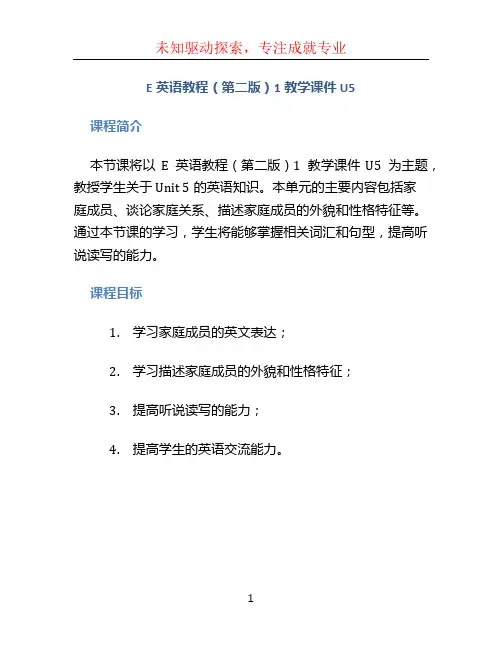
E英语教程(第二版)1教学课件U5课程简介本节课将以E英语教程(第二版)1教学课件U5为主题,教授学生关于Unit 5的英语知识。
本单元的主要内容包括家庭成员、谈论家庭关系、描述家庭成员的外貌和性格特征等。
通过本节课的学习,学生将能够掌握相关词汇和句型,提高听说读写的能力。
课程目标1.学习家庭成员的英文表达;2.学习描述家庭成员的外貌和性格特征;3.提高听说读写的能力;4.提高学生的英语交流能力。
课程内容1. 家庭成员的英文表达•家庭成员的基本词汇:father, mother, brother, sister, etc.•家庭成员的扩展词汇:grandfather, grandmother, uncle, aunt, cousin, etc.2. 谈论家庭关系•表达亲属关系的词汇:parents, children, siblings, etc.•描述家庭关系的句型:My father is my mother’s husband. My brother is my sister’s sibling.3. 描述家庭成员的外貌和性格特征•描述外貌特征的词汇:tall, short, slim, overweight, etc.•描述性格特征的词汇:friendly, outgoing, serious, funny, etc.•描述家庭成员外貌和性格特征的句型:My father is tall and serious. My sister is short and funny.课堂活动1.情景对话:学生分组进行家庭成员和家庭关系的对话练习,使用学过的词汇和句型。
2.描述练习:学生通过看图片或老师给出的提示,描述家庭成员的外貌和性格特征,进行口语练习。
3.写作练习:学生根据提示,写一篇关于自己家庭的文章,包括家庭成员的介绍和他们的外貌和性格特征。
自主学习任务1.阅读教材对应单元的课文,理解并掌握相关的词汇和句型;2.通过影视、音频等资源,进一步了解家庭成员和家庭关系的表达方式;3.多听多讲多读多写,提高英语语感和口语表达能力;4.课后复习,做相关练习题巩固所学知识。
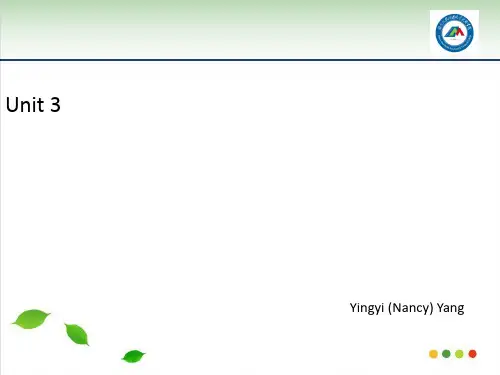
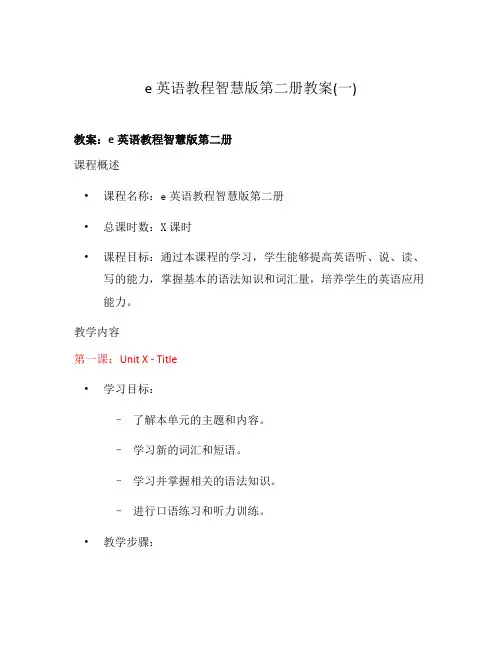
e英语教程智慧版第二册教案(一)教案:e英语教程智慧版第二册课程概述•课程名称:e英语教程智慧版第二册•总课时数:X课时•课程目标:通过本课程的学习,学生能够提高英语听、说、读、写的能力,掌握基本的语法知识和词汇量,培养学生的英语应用能力。
教学内容第一课:Unit X - Title•学习目标:–了解本单元的主题和内容。
–学习新的词汇和短语。
–学习并掌握相关的语法知识。
–进行口语练习和听力训练。
•教学步骤:1.引入新课:通过话题导入新的单元内容,激发学生学习兴趣。
2.学习词汇和短语:介绍本单元的重点词汇和短语,进行词义理解和例句展示。
3.学习语法知识:教授本单元相关的语法知识,通过例句和练习加深理解。
4.口语练习:组织学生进行口语练习,模拟真实情境,提高口语表达能力。
5.听力训练:进行听力练习,培养学生的听力理解能力。
6.课堂小结:对本节课的重点内容进行总结,并布置相关的课后作业。
第二课:Unit X - Title•学习目标:–复习上节课的内容。
–学习新的词汇和短语。
–继续学习相关的语法知识。
–进行阅读理解和写作练习。
•教学步骤:对知识点的记忆。
2.学习词汇和短语:介绍本单元的新词汇和短语,进行词义理解和例句展示。
3.学习语法知识:继续教授本单元相关的语法知识,通过例句和练习加深理解。
4.阅读理解:组织学生进行阅读理解练习,培养学生的阅读理解能力。
5.写作练习:引导学生进行写作练习,要求学生运用所学的语法知识和词汇进行写作。
6.课堂小结:对本节课的重点内容进行总结,并布置相关的课后作业。
第三课:Unit X - Title•学习目标:–复习上节课的内容。
–学习新的词汇和短语。
–继续学习相关的语法知识。
–进行听力和口语训练。
•教学步骤:对知识点的掌握程度。
2.学习词汇和短语:介绍本单元的新词汇和短语,进行词义理解和例句展示。
3.学习语法知识:继续教授本单元相关的语法知识,通过例句和练习加深理解。
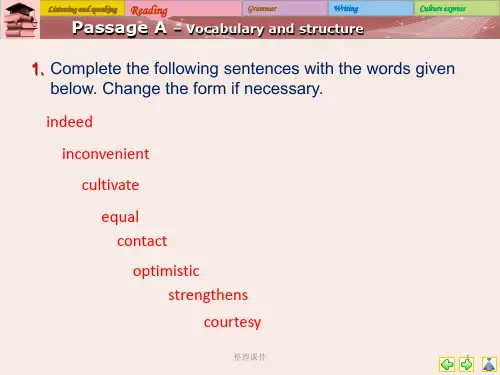
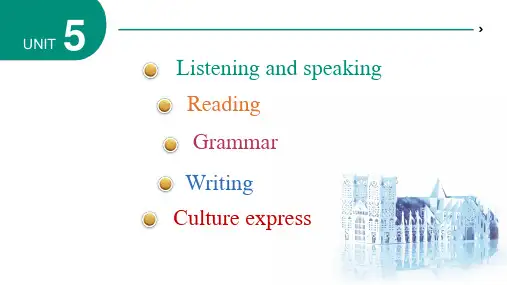
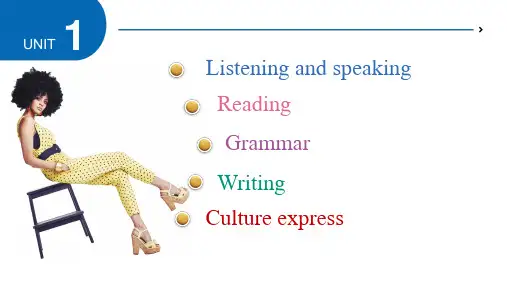
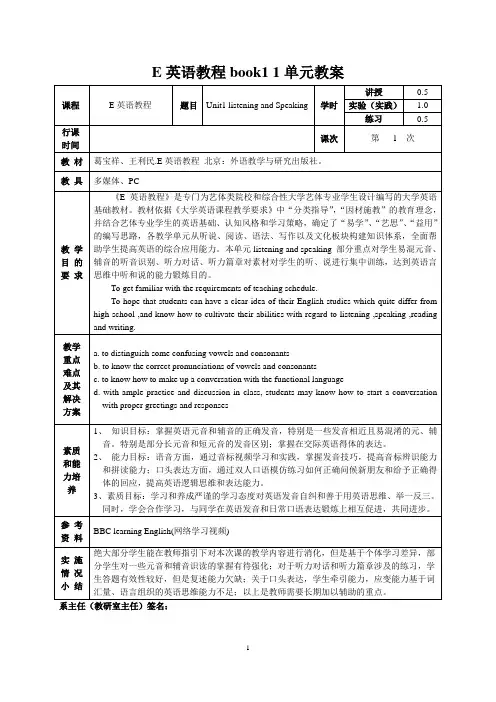
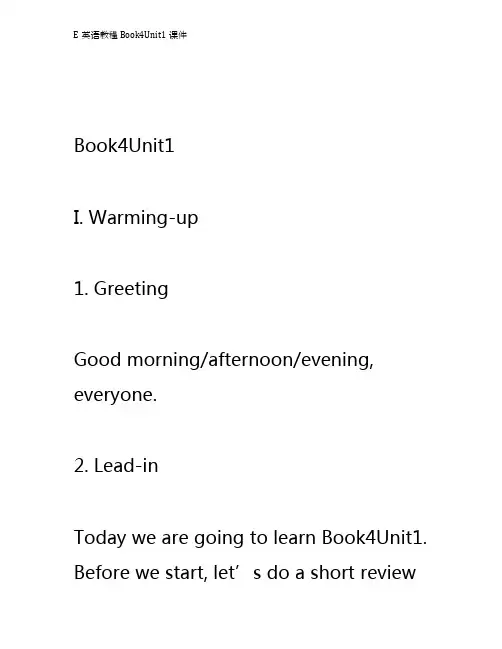
Book4Unit1I. Warming-up1. GreetingGood morning/afternoon/evening, everyone.2. Lead-inToday we are going to learn Book4Unit1. Before we start, let’s do a short reviewof what we have learned in the last lesson.II. Pre-reading1. Vocabulary(1) Look at the pictures and try to guess the words.(2) Ask the students to match the words with the pictures.(3) Check the answers.2. DiscussionDiscuss the following questions in groups.Q1: What do you think of the pictures?Q2: What do you think the story is about?Q3: What do you think will happen inthe story?III. Reading1. Read the passageRead the passage and answer the questions.2. ComprehensionQ1: What did the old man do when he saw the little girl?A1: The old man smiled and waved at the little girl.Q2: What did the little girl do when she saw the old man?A2: The little girl smiled and waved back at the old man.Q3: What did the old man give the little girl?A3: The old man gave the little girl a beautiful flower.IV. Post-reading1. DiscussionDiscuss the following questions in groups.Q1: What do you think of the story?Q2: What do you think the old man and the little girl were thinking?Q3: What do you think the old man and the little girl learned from this story?2. SummarySummarize the story in your own words.V. HomeworkWrite a story about a kind old man and a little girl.。
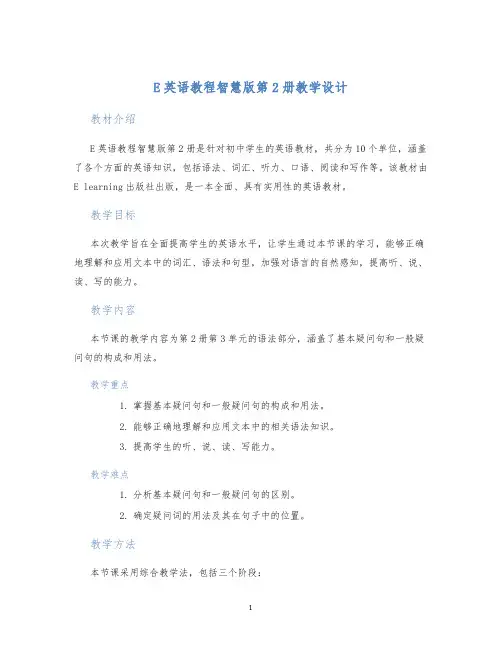
E英语教程智慧版第2册教学设计教材介绍E英语教程智慧版第2册是针对初中学生的英语教材,共分为10个单位,涵盖了各个方面的英语知识,包括语法、词汇、听力、口语、阅读和写作等。
该教材由E learning出版社出版,是一本全面、具有实用性的英语教材。
教学目标本次教学旨在全面提高学生的英语水平,让学生通过本节课的学习,能够正确地理解和应用文本中的词汇、语法和句型,加强对语言的自然感知,提高听、说、读、写的能力。
教学内容本节课的教学内容为第2册第3单元的语法部分,涵盖了基本疑问句和一般疑问句的构成和用法。
教学重点1.掌握基本疑问句和一般疑问句的构成和用法。
2.能够正确地理解和应用文本中的相关语法知识。
3.提高学生的听、说、读、写能力。
教学难点1.分析基本疑问句和一般疑问句的区别。
2.确定疑问词的用法及其在句子中的位置。
教学方法本节课采用综合教学法,包括三个阶段:第一阶段:导入(5分钟)本节课的导入环节将通过一个包含基本疑问词和一般疑问句的小故事,引导学生探究疑问句的构成和用法,营造轻松愉悦的学习氛围。
第二阶段:讲解与练习(45分钟)这个阶段的教学主要围绕两个方面展开:1.通过PPT讲解基本疑问句和一般疑问句的构成和用法,让学生掌握基本语法知识。
2.组织小组练习,老师提供一些简单的疑问句,要求学生交流沟通,表达自己的观点,加强英语口语和听说能力。
第三阶段:总结(10分钟)在教学的最后十分钟,老师会对本节课的重点难点进行总结,强化学生对知识点的理解和记忆,让学生对本课所学内容有一个全面的认识。
教学资源为了保证教学效果,本节课需要用到以下教学资源:1.小故事PPT2.基本疑问句和一般疑问句练习题PPT3.随堂测试试题教学评价本节课的教学评价主要从以下几个方面进行:1.学生听力、口语、阅读、写作能力的提高情况。
2.学生对所学知识的理解和掌握情况。
3.学生课堂参与和表现情况。
教学反思本节课教学效果良好,学生掌握了语法知识,并在小组练习中积极参与,表现积极热情,但部分学生的写作能力和课堂行为还有待提高。